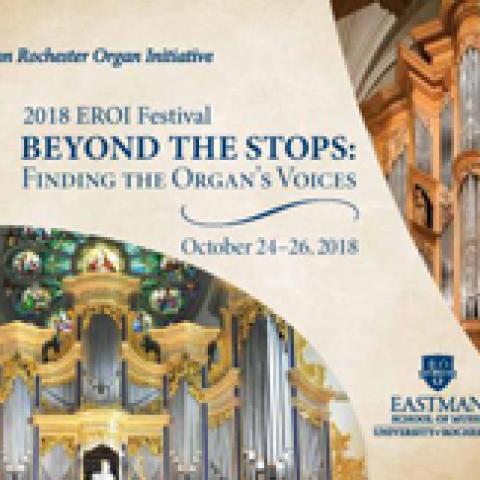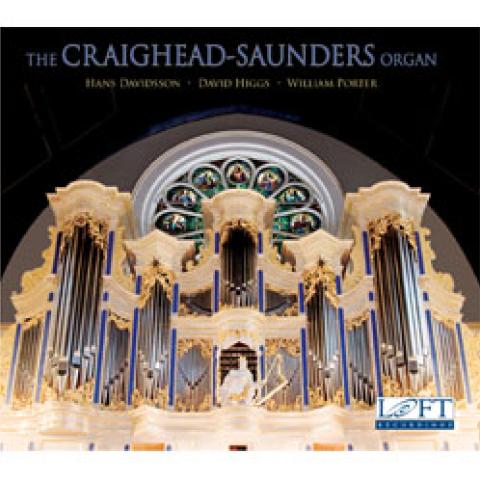
The 2006 EROI Festival was presented by the Eastman School of Music and the Westfield Center October 12–15. The topic was “Aspects of American Organ Building in the 20th Century with emphasis on E. M. Skinner and John Brombaugh.”
The Eastman Rochester Organ Initiative (EROI)
When the Eastman School of Music opened its doors in 1921, it housed the largest and most lavish organ collection in the nation, befitting the interests of its founder, George Eastman. Mr. Eastman provided the school with opulent facilities and stellar faculty, creating an expansive vision for organ art and education in the 20th century.
Over the years, the Eastman School has built on this vision by offering one of the most distinguished organ programs in the world. In keeping with this tradition of excellence, the Eastman School of Music has embarked on a long-range plan, the Eastman Rochester Organ Initiative (EROI), which will extend George Eastman’s vision into the 21st century.
With the aim of making Rochester a global center for organ performance, research, building, and preservation, the Eastman School will assemble a collection of new and historic organs unparalleled in North America. An incomparable teaching resource, this collection will offer access to organs of diverse styles and traditions to talented young musicians from around the world.
Tourists, scholars, and music lovers will be drawn to Rochester to hear the varied sounds of these extraordinary instruments. The Italian Baroque organ inaugurated within the frame of the EROI Festival 2005 marks the first concrete milestone in EROI Phase One. A new instrument closely modeled after a Lithuanian organ built by Casparini in 1776 will be constructed and installed in Christ Church (Episcopal) by 2008, in cooperation with the Episcopal Diocese of Rochester.
The restoration of the historic Skinner organ, housed in the Eastman School’s Kilbourn Hall, and the restoration and replacement of the school’s fourteen practice organs, will complete the initial phase of this ten-year plan.
—The EROI Brochure 2006
See
Photo composition and text: Joel H. Kuznik Photo credit: Nicole Marane<.i>
Organs
At the opening of the EROI Festival William Porter, known for his traditional improvisatory skills, delighted attendees with an authentic performance on the mighty Wurlitzer Opus 1492 (1926, 121 stops, 12 ranks; restored by the Rochester Theatre Organ Society) at the Rochester Museum and Science Center.
Bozeman-Gibson Opus 24 (1984, 23 stops, 31 ranks, with gifts of Vox Humana by Paul Fritts, 2005, and Pedal 16' Posaunenbass by Flentrop Orgelbouw, 2006), modeled on Gottfried Silbermann’s instrument at Grosshartmansdorf, Germany. Currently on loan to Eastman and housed at Asbury First United Methodist Church.
“Gleason’s Dream Machine” designed by the legendary Harold Gleason for Eastman’s Kilbourn Hall, Skinner Opus 325 (1922, 6,030 pipes, 91 ranks, 83 stops), scheduled to be restored by 2010. Today it is Rochester’s largest organ.
John Brombaugh’s landmark 1972 Opus 9 (20 stops, 29 ranks), originally built for Ashland Avenue Baptist in Toledo, Ohio; now on loan to Sacred Heart Cathedral (RC), Rochester until 2008, when they receive a 52-stop Paul Fritts organ. The compact casework and pipework of extraordinary craftsmanship complement the remarkable sound.
Holtkamp organ (1962, 40 stops, 45 ranks) at the Lutheran Church of the Incarnate Word, with its modern façade and neo-baroque tonal concept, typical of the mid-20th century.
Builder John Brombaugh discusses the concept of his Opus 9 and the importance of “vocale” voicing, inspired by his experience as a boy singer and found in old instruments throughout Europe, typically in Principal sounds to imitate the human voice.
Historic Pennsylvania Samuel Bohler organ (1869, 8 stops, 7 ranks), with a clear, crisp sound, at the Lutheran Church of the Incarnate Word. Built for Muddy Creek Presbyterian Church, Pennsylvania; restored by R. J. Brunner and Co. in 2006.
Console of the South End Organ, Aeolian Opus 947 (1904, 59 stops, 66 ranks), in the George Eastman House, where Harold Gleason played for breakfast each day and musicales twice a week with a resident string quartet. Still playable by rolls or console.
Computer image of the Craighead-Saunders organ to be installed in Christ Church (Episcopal) beginning July 2007, with completion in 2008. The organ is modeled on the exceptional Casparini organ (1776) at the Holy Ghost Church in Vilnius, Lithuania.
John Brombaugh and friends—how many do you know? Left to right: builder Martin Pasi, Aaron Reichert (Taylor & Boody), Munetaka Yokota (GOArt, Göteborg), John Brombaugh, builder George Taylor, builder Paul Fritts, Bruce Shull (Paul Fritts), Frits Elhout (Flentrop), and Mats Arvidsson (GOArt, Göteborg).




